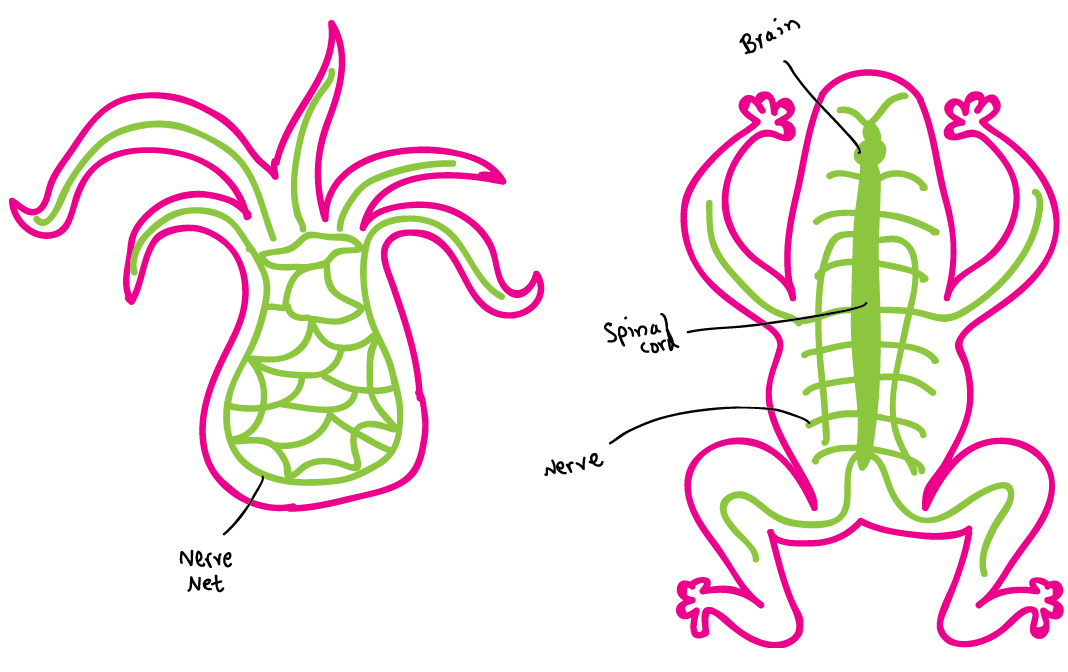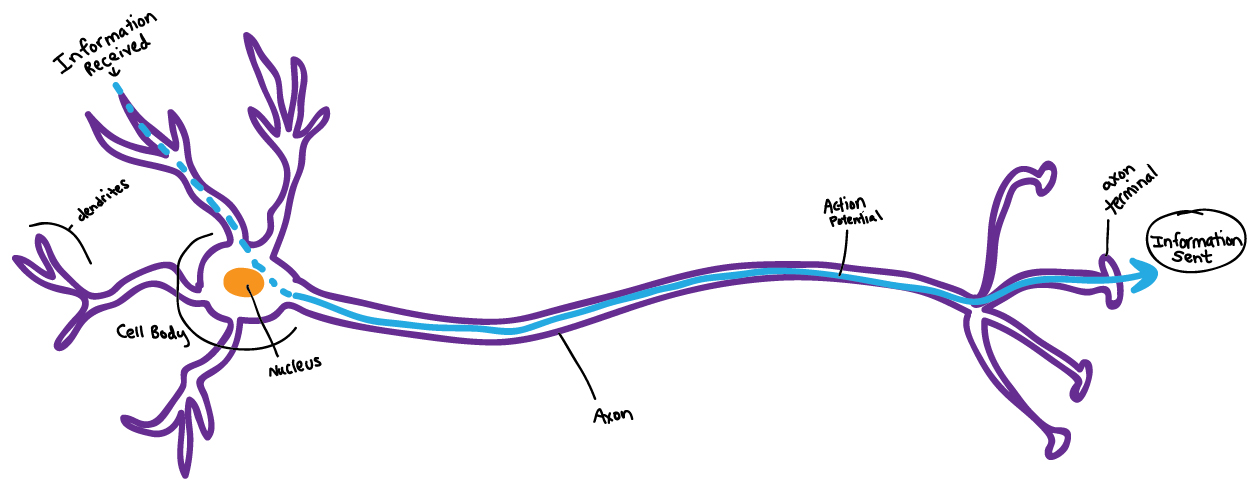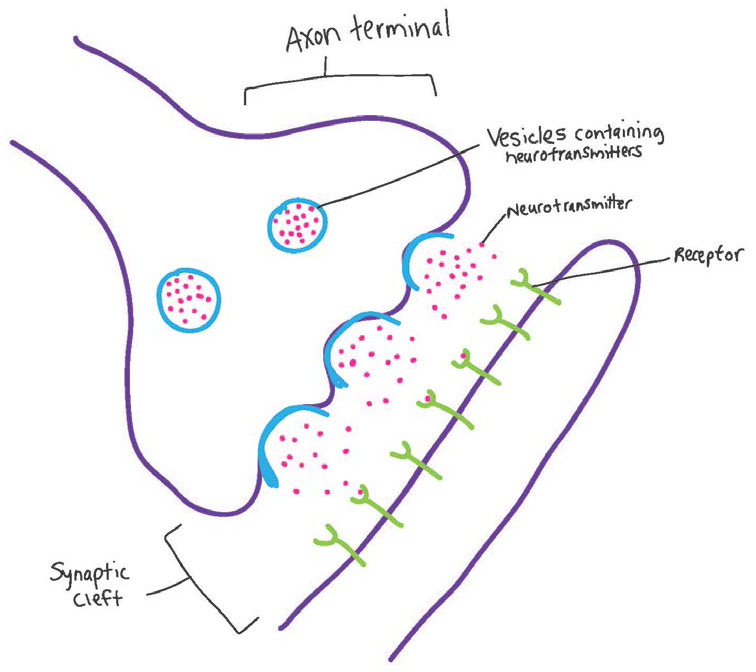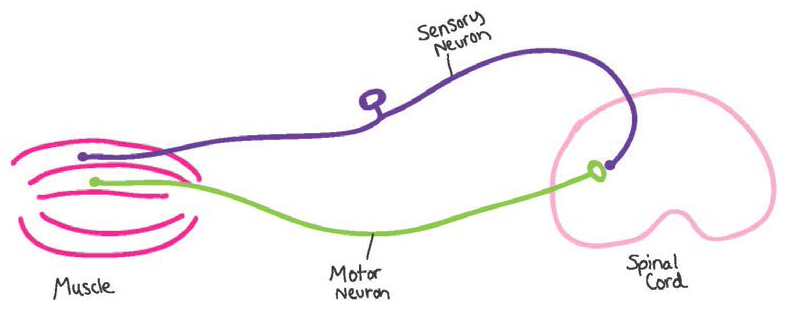CHAPTER SUMMARY
35.1 ANIMAL NERVOUS SYSTEMS ALLOW ORGANISMS TO SENSE AND RESPOND TO THE ENVIRONMENT, COORDINATE MOVEMENT, AND REGULATE INTERNAL FUNCTIONS OF THE BODY.
- Nerve cells, or neurons, receive and send signals and are the functional unit of the nervous system.
- Animal nervous systems include three types of neuron: sensory neurons that respond to signals, interneurons that integrate and process sensory information, and motor neurons that produce a response.
- Ganglia are localized collections of nerve cell bodies that integrate and process information.
- Simply organized animals, such as cnidarians, have a nerve net to coordinate sensory and motor function.
- Forward locomotion led to the evolution of specialized sense organs in the head, along with concentrated groupings of nerve cells to form ganglia and a brain.
35.2 THE NEURON IS THE FUNCTIONAL UNIT OF THE NERVOUS SYSTEM. NEURONS HAVE DENDRITES THAT RECEIVE INFORMATION AND AXONS THAT TRANSMIT INFORMATION.
- Neurons share a common organization, with dendrites that receive inputs, a cell body that receives and sums the inputs, and axons that transmit signals to other nerve cells.
- Glial cells provide nutritional and physical support for neurons.
- In vertebrates, glial cells also produce the myelin sheath that insulates axons, increasing the speed of nerve impulses.
35.3 THE ELECTRICAL PROPERTIES OF NEURONS ALLOW THEM TO COMMUNICATE RAPIDLY WITH ONE ANOTHER.
- Neurons have electrically excitable membranes that code information by changes in membrane voltage and transmit information in the form of electrical signals called action potentials.
- Ion channels open and close in response to changes in membrane voltage, underlying the production of action potentials in nerve cells.
- Action potentials fire in an all-or-nothing fashion followed by a brief refractory period.
- Action potentials are conducted in a saltatory fashion in myelinated axons, firing at nodes of Ranvier where the axon membrane is exposed and not insulated by myelin.
- Most neurons communicate by chemical synapses formed between an axon terminal and a neighboring nerve or muscle cell.
- Communication across the synapse occurs when an arriving action potential triggers the release of neurotransmitters from vesicles within the axon terminal.
- Neurotransmitters released from presynaptic vesicles bind to receptors in the postsynaptic membrane, causing either an excitatory or an inhibitory stimulus.
- Excitatory stimuli depolarize the membrane, producing an excitatory postsynaptic potential (EPSP), whereas inhibitory stimuli hyperpolarize the membrane, producing an inhibitory postsynaptic potential (IPSP).
35.4 ANIMAL NERVOUS SYSTEMS CAN BE ORGANIZED INTO CENTRAL AND PERIPHERAL COMPONENTS.
- Animal nervous systems are organized into central and peripheral components called the central nervous system (CNS) and peripheral nervous system (PNS).
- The central nervous system includes the brain and one or more main trunks of nerve cells, such as the spinal cord. The peripheral nervous system is distributed throughout the animal’s body and is composed of sensory and motor nerve cells.
- In many invertebrates and vertebrates, the peripheral nervous system is divided into voluntary and involuntary components.
- In vertebrates, the voluntary component is somatic, and the involuntary is autonomic.
- The autonomic system regulates body functions through opposing actions of the sympathetic and parasympathetic divisions.
- The nervous system helps to regulate physiological functions to actively maintain stable conditions inside a cell or an organism, a property known as homeostasis.
- Homeostasis is often achieved by negative feedback, in which the response inhibits the stimulus.
- Simple reflex circuits can involve as few as two neurons: a sensory neuron from the periphery that synapses with a motor neuron in the spinal cord that sends a signal to a muscle.
Self-Assessment Question 1
Diagram a simple nervous system of an animal that lacks cephalization and compare that system with the general organizational features of a nervous system that exhibits cephalization.
Show Model Answer
Model Answer:

Self-Assessment Question 2
Name the three basic categories of neuron and describe their functions.
Show Model Answer
Model Answer:
Three basic categories of neurons are: (1) sensory neurons, which respond to physical features such as temperature, light, and touch or to chemical signals such as odor and taste; (2) interneurons, which process the information received by the sensory neurons and transmit it to different body regions; and (3) motor neurons, which are at the end of the pathway and produce a suitable response based on the information from the sensory and interneurons.
Self-Assessment Question 3
Diagram and label the basic features of a neuron, indicating where information is received and where it is sent.
Show Model Answer
Model Answer:

Self-Assessment Question 4
Graph an action potential, showing the change in electrical potential on the y-axis and time on the x-axis. Indicate on the graph the phases when voltage-gated Na+ and K+ ion channels are opened and when they are closed.
Show Model Answer
Model Answer:

Self-Assessment Question 5
Explain what is meant by saying action potentials are “all-or-nothing.”
Show Model Answer
Model Answer:
An action potential is said to be “all-or-nothing” because the magnitude of the action potential is always the same, regardless of the strength of the initial stimulating input.
Self-Assessment Question 6
Explain why action potentials propagate along an axon only in a single direction.
Show Model Answer
Model Answer:
A neuron cannot fire a second action potential during the refractory period, when the inner membrane voltage falls below and then returns to resting potential. The action potential is propagated along the axon in only a single direction because the refractory period prevents the membrane from reaching its threshold too quickly after an action potential and firing an action potential in the reverse direction.
Self-Assessment Question 7
Briefly describe how myelinated axons increase the speed of signal transmission.
Show Model Answer
Model Answer:
The myelin sheath insulates the axon, spreading the charge from a local action potential over a much greater distance along the axon’s length. The axon membrane is exposed at regular intervals at sites called nodes of Ranvier that lie between adjacent segments wrapped with myelin.The action potential jumps from node to node, greatly increasing the speed of transmission.
Self-Assessment Question 8
Diagram a chemical synapse, labeling the vesicles that contain neurotransmitter molecules and the receptors that bind the neurotransmitter to produce either an inhibitory or excitatory stimulus in the postsynaptic cell.
Show Model Answer
Model Answer:

Self-Assessment Question 9
Briefly describe how neurotransmitter binding to receptors on a postsynaptic cell causes inhibition or excitation.
Show Model Answer
Model Answer:
Neurotransmitters binding to receptors on the postsynaptic membrane can elicit an excitatory response if they depolarize the postsynaptic membrane. Excitatory neurotransmitters trigger the opening of Na+ channels. Neurotransmitters cause an inhibitory response if they bind to receptors and hyperpolarize the postsynaptic membrane. Inhibitory neurotransmitters trigger the opening of Cl-, or sometimes K+, channels.
Self-Assessment Question 10
Describe how vertebrate nervous systems are organized into voluntary and involuntary components, listing which functions of an animal are controlled by each component.
Show Model Answer
Model Answer:
The voluntary, or somatic, component of the vertebrate nervous system controls the sensing and response to external stimuli, like sight or smell. The involuntary, or autonomic, component of the vertebrate nervous system controls many bodily functions like heartbeat and digestion.
Self-Assessment Question 11
Diagram a simple circuit that includes a sensory neuron that synapses with a motor neuron to produce a reflex. Indicate where in the nervous system this synapse is found.
Show Model Answer
Model Answer:
